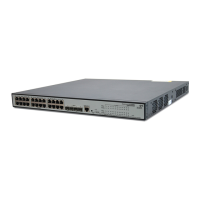410
ACL configuration
ACL overview
With the growth of network scale and network traffic, network security and bandwidth allocation become
more and more critical to network management. Packet filtering can be used to efficiently prevent illegal
access to networks and to control network traffic and save network resources. One way to implement packet
filtering is to use access control lists (ACLs).
An ACL is a set of rules (or a set of permit or deny statements) for determining which packets can pass and
which ones should be rejected based on match criteria such as source address, destination address, and
port number. ACLs are widely used with technologies such as QoS, where traffic identification is desired.
Introduction to IPv4 ACL
IPv4 ACL classification
IPv4 ACLs, identified by ACL numbers, fall into the following categories, as shown in 1.
1. IPv4 ACL categories
Cate
or
ACL number Match criteria
Basic IPv4 ACL
2000 to 2999
Source IP address
Advanced IPv4 ACL
3000 to 3999
Source IP address, destination IP address, protocol
carried over IP, and other Layer 3 or Layer 4 protocol
header information
Ethernet frame header ACL
4000 to 4999
Layer 2 protocol header fields such as source MAC
address, destination MAC address, 802.1p
precedence, and link layer protocol type
IPv4 ACL match order
An ACL may consist of multiple rules, which specify different match criteria. These match criteria may have
overlapping or conflicting parts. The match order determines how packets should be matched against the
rules. The comparison of a packet against ACL rules stops immediately after a match is found. The packet
is then processed as per the rule.
The following types of IPv4 ACL match orders are available:
config—Compares packets against ACL rules in the order that the rules are configured.
auto—Compares packets against ACL rules in the depth-first match order.
The term depth-first match has different meanings for different types of IPv4 ACLs.

